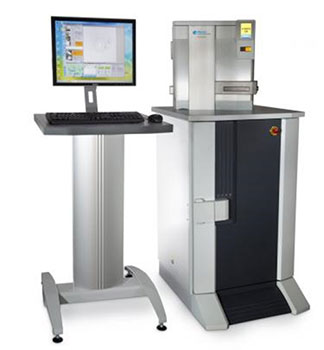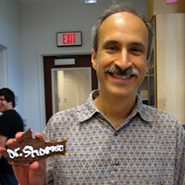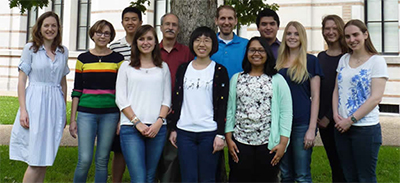|
Monthly message

Open Letter to Rigaku Oxford Diffraction Customers
June 30, 2015
Dear Customer:
I would like to take this opportunity to address the recent acquisition of Agilent's XRD business by Rigaku Corporation and the subsequent creation a new combined Rigaku Oxford Diffraction single crystal group.
Our decision to make this acquisition was based on a number of things, but key among those reasons was the synergy that we recognized between the two groups. Rigaku's strength in the structural biology market and Oxford Diffraction's strength in the field of chemical crystallography will be combined to create a stronger overall single crystal organization. As the boundaries between chemical crystallography and macromolecular crystallography continue to be reduced, synergistic use of our combined technologies will lead to better products for both sets of customers.
We felt it was particularly important to bring back the name of "Oxford Diffraction" as it is synonymous with innovative, leading edge hardware and software that has greatly expanded the capabilities of chemical crystallography over the last 15 years. During the same period, Rigaku was advancing the development of X-ray source technology and multilayer optics as applied to the expanded number of life science and structural genomics projects around the world. Thus our new name of "Rigaku Oxford Diffraction" symbolizes our continued commitment to further advance instrumentation technologies for all fields of single crystal analysis.
We now have factories in Japan and Poland that are involved in Rigaku Oxford Diffraction instrument production and single crystal products from these factories will be branded in the same way. Our R&D groups have already started working together and the overall integration process is progressing faster than we expected.
All of us at Rigaku Oxford Diffraction look forward to serving you in the future as your vendor for diffraction products. Our goal is to be an intimate part of the success of your research program. Our own measure of success can only be achieved when we deem that our customers are producing better results and succeeding at their own research faster and quicker than before.
Please feel to contact me at any time if you have any specific questions.
Sincerely,
Paul Swepston
Brand Manager, Rigaku Oxford Diffraction
paul.swepston@Rigaku.com
Crystallography
in the news
June 1, 2015. HarkerBio LLC has signed a new agreement with Albany Molecular Research Inc. to co-market drug discovery services on a global scale. The three-year deal gives AMRI (NASDAQ: AMRI) access to Buffalo-based HarkerBio’s structure-based expertise, while HarkerBio customers will be able to access and benefit from AMRI’s global capabilities, including drug discovery platforms and solutions.
June 1, 2015. Cryo-EM has made this marked jump in the last three or four years in terms of resolution, so that we can go from just seeing the general outline of a protein, what people used to refer to as 'blob-ology,' and now see, actually, the atomic structure.
June 1, 2015. A team led by DESY scientists has designed, fabricated and successfully tested a novel X-ray lens that produces sharper and brighter images of the nano world. The lens employs an innovative concept to redirect X-rays over a wide range of angles, making a high convergence power. The researchers manufactured a wedged lens from 5500 alternating layers of silicon carbide (SiC) and tungsten (W), varying in thickness. The final lens cut from these deposits was 40 micrometres (millionths of a metre) wide, 17.5 micrometres thick and 6.5 micrometres deep.
June 5, 2015. A new pioneering method developed by biochemists from Trinity College, Dublin addresses most of the bottlenecks of traditional crystallization. The in meso in situ serial crystallography (IMISX) excludes the burdensome crystal transfers, providing instead an intriguing possibility to study their structure in situ - meaning in the place in which they grew.
June 9, 2015. An international team led by researchers at UCLA’s Henry Samueli School of Engineering and Applied Science and California NanoSystems Institute has used X-ray scattering to identify an unexpectedly general set of rules that determine which molecules can cause the immune system to become vulnerable to the autoimmune disorders lupus and psoriasis.
June 15, 2015. The international event Drug Discovery Conference will take place from 27 to 29 August, 2015 in Riga, Latvia. The conference will cover topics from organic synthesis and medicinal chemistry to biological and pharmacological applications of novel ligands. This conference is organized in the frame of the FP7 project INNOVABALT (Strengthening the research and innovative capacities of the Latvian Institute of Organic Synthesis, the leading Baltic regional center for drug discovery).
June 18, 2015. Scientists at The Scripps Research Institute (TSRI) have teamed up with several other institutions and pharmaceutical companies, including the University of Southern California (USC), San Diego's Receptos Inc. and Japanese company Ono Pharmaceutical Co., Ltd., to publish the first 3D structures of a family of small fat molecules known as lysophosphatidic acid (LPA), part of a larger class of fat molecules (lysophospholipids) implicated in many diseases of the brain and in normal physiology throughout the body.
June 18, 2015. Researchers have designed a computer method that looks at two different snapshots of the same protein structures, captured through crystallography, and identified hinge points, or "hot spots," of flexibility. In doing so, the researchers successfully affirmed the premise that proteins use the ranges of motion that are most efficient.
June 18, 2015. Song Tan, professor of biochemistry and molecular biology at Penn State, has been selected to receive the 2015 Penn State Faculty Scholar Medal for Outstanding Achievement in the Life and Health Sciences. Tan's lab was the first to determine the atomic structure of a chromosome-regulatory protein bound to the nucleosome, the fundamental component of chromatin, and also was the first to determine the crystal structure of a chromatin enzyme in the act of regulating a gene's expression on a nucleosome.
Product spotlight: PX Scanner
In situ X-ray crystallography system with imager
Imaging and X-ray diffraction collection for your crystals directly from crystallization plates
The PX Scanner is a fully integrated system for in situ screening and data collection of crystals in SBS crystallization plates and microfluidic chips. This turnkey system combines sample visualization and in situ X-ray screening to deliver a compact tool to evaluate sample quality without the need to remove crystals from their protected growth environment. The system includes a microfocus sealed tube Cu X-ray generator, crystal imaging system, automated tray stage with 6 degrees of tilt, CCD detector and intuitive CrystalEyes software. With the PX Scanner, one can quickly identify whether a crystal contains salt or protein and evaluate diffraction quality for samples without removal from the crystallization plate.

Visit Rigaku.com for more information about the PX Scanner.
Lab spotlight: Shamoo Laboratory
Professor Yousif Shamoo
Vice Provost for Research
Professor, BioSciences
Director, Institute of Biosciences and Bioengineering
Rice University

ADAPTATION & ATOMS: exploring the biophysical
origins of molecular evolution
- Methicillin resistant Staphylococcus aureus (MRSA) kills more Americans per year than HIV/AIDS, emphysema, Parkinson’s diseases and homicides COMBINED. (Infectious Disease Society of America)
- Nearly 2 million Americans per year will develop hospital acquired infections (HAIs) (99,000 deaths)
- Sepsis and pneumonia alone kills ~50,000 American per year and costs 21-34 billion dollars mostly due to MDR pathogens
The Shamoo group's interest in molecular evolution is stimulated by the rise in drug resistant pathogens and how understanding the physical basis for adaptation can be used for prediction of resistance and the identification of new targets and strategies for antimicrobial therapies. By combining approaches from biophysics and experimental evolution they are able to identify and characterize intermediates along the mutational pathways of adaptation and then link those intermediates to the overall evolutionary trajectory of the bacterial populations. Adaptive changes in protein sequence and expression impact organismal fitness and, consequently, dictate population dynamics. By combining experimental evolution with molecular biophysics they take a systems level view of adaptation and link it to the molecular mechanism responsible for the resulting evolutionary dynamics.

Useful link:
ENTANGLE: a tool for the analysis of protein-nucleic acid complexes
Professor Yousif Shamoo
Rice University
Entangle is a JAVA program that reads a PDB file containing a nucleic-acid protein complex and gives a listing of interactions that occur at the interface between the nucleic-acid/protein complex. These interactions are then classified into hydrogen bonds, electrostatic, hydrophobic, and Van der Waals. Entangle also recognizes when a stacking interaction occurs between two aromatic residues. In addition to a listing, Entangle allows the user to probe the interface in three-dimensions.
Selected
recent crystallographic papers
Practical macromolecular cryocrystallography. Pflugrath, J. W. Acta Crystallographica: Section F, Structural Biology Communications. Jun2015, Vol. 71 Issue 6, p622-642. 21p. DOI: 10.1107/S2053230X15008304.
DATASW, a tool for HPLC-SAXS data analysis. Shkumatov, Alexander V.; Strelkov, Sergei V. Acta Crystallographica: Section D. Jun2015, Vol. 71 Issue 6, p1347-1350. 4p. DOI: 10.1107/S1399004715007154.
Structure and function of serotonin G protein-coupled receptors. McCorvy, John D.; Roth, Bryan L. Pharmacology & Therapeutics. Jun2015, Vol. 150, p129-142. 14p. DOI: 10.1016/j.pharmthera.2015.01.009.
The structure and conformational switching of Rap1B. Noguchi, Hiroki; Ikegami, Takahisa; Nagadoi, Aritaka; Kamatari, Yuji O.; Park, Sam-Yong; Tame, Jeremy R.H.; Unzai, Satoru. Biochemical & Biophysical Research Communications. Jun2015, Vol. 462 Issue 1, p46-51. 6p. DOI: 10.1016/j.bbrc.2015.04.103.
Recrystallization: a method to improve the quality of protein crystals. Hou, Hai; Liu, Yue; Wang, Bo; Jiang, Fan; Tao, Hao-Ran; Hu, Shan-Yang; Yin, Da-Chuan. Journal of Applied Crystallography. Jun2015, Vol. 48 Issue 3, p758-762. 5p. DOI: 10.1107/S1600576715005129.
A step towards long-wavelength protein crystallography: subjecting protein crystals to a vacuum. Panjikar, Santosh; Thomsen, Lars; O'Donnell, Kane Michael; Riboldi-Tunnicliffe, Alan. Journal of Applied Crystallography. Jun2015, Vol. 48 Issue 3, p913-916. 4p. DOI: 10.1107/S1600576715006147.
Why crystal structure analysis works: a one-dimensional crystallography teaching tool. Pinkerton, A. Alan. Journal of Applied Crystallography. Jun2015, Vol. 48 Issue 3, p901-905. 5p. DOI: 10.1107/S1600576715007116.
Advances in membrane protein crystallography: in situ and in meso data collection. Weyand, Simone; Tate, Christopher G. Acta Crystallographica: Section D. Jun2015, Vol. 71 Issue 6, p1226-1227. 2p. DOI: 10.1107/S1399004715008317.
Structure determination of an integral membrane protein at room temperature from crystals in situ. Axford, Danny; Foadi, James; Hu, Nien-Jen; Choudhury, Hassanul Ghani; Iwata, So; Beis, Konstantinos; Evans, Gwyndaf; Alguel, Yilmaz. Acta Crystallographica: Section D. Jun2015, Vol. 71 Issue 6, p1228-1237. 10p. DOI: 10.1107/S139900471500423X.
Synthesis, growth, molecular structure and spectral studies of 1,3 diglycinyl thiourea by density functional method. Kumar, M.; Kanagadurai, R.; Mani, G.; Gunasekaran, S.; Kumaresan, S. Optik - International Journal for Light & Electron Optics. Jun2015, Vol. 126 Issue 11/12, p1117-1122. 6p. DOI: 10.1016/j.ijleo.2015.03.019.
Nucleation of Sub-Micrometer Protein Crystals in Square-ShapedMacroporous Silicon Structures. U. Salazar-Kuri; J. O. Estevez; E. E. Antunez; B. S. Martinez-Aguila; J. B. Warren; Babak Andi; M. L. Cerniglia; V. Stojanoff; V. Agarwal. Crystal Growth & Design. Jun2015, Vol. 15 Issue 6, p2801-2808. 8p. DOI: 10.1021/acs.cgd.5b00243.
Synthesis and structure of dicopper(II) complexes bridged by N-(5-chloro-2-hydroxyphenyl)-N'-[3-(methy lamino)propyl]oxamide: Evaluation of DNA/protein binding, DNA cleavage, and in vitro anticancer activity. Xu, Xiao-Wen; Li, Xue-Jie; Zhu, Ling; Li, Yan-Tuan; Wu, Zhi-Yong; Yan, Cui-Wei. Journal of Photochemistry & Photobiology B: Biology. Jun2015, Vol. 147, p9-23. 15p. DOI: 10.1016/j.jphotobiol.2015.03.004.
Structural characterization of metal binding to a cold-adapted frataxin. Noguera, Martín; Roman, Ernesto; Rigal, Juan; Cousido-Siah, Alexandra; Mitschler, André; Podjarny, Alberto; Santos, Javier. Journal of Biological Inorganic Chemistry. Jun2015, Vol. 20 Issue 4, p653-664. 12p. DOI: 10.1007/s00775-015-1251-9.
Iron(II) complexes containing the 2,6-bis-iminopyridyl moiety. Synthesis, characterization, reactivity, and DNA binding. Shaban, Shaban Y.; El-Shafai, Nagi; Mansour, Hanaa; Van Eldik, Rudi. Journal of Coordination Chemistry. Jun2015, Vol. 68 Issue 12, p2054-2064. 11p. DOI: 10.1080/00958972.2015.1031656.
Differential ultracentrifugation coupled to small-angle X-ray scattering on macromolecular complexes. Hynson, Robert M. G.; Duff, Anthony P.; Kirby, Nigel; Mudie, Stephan; Lee, Lawrence K. Journal of Applied Crystallography. Jun2015, Vol. 48 Issue 3, p769-775. 7p. DOI: 10.1107/S1600576715005051.
SCT: a suite of programs for comparing atomistic models with small-angle scattering data. Wright, David W.; Perkins, Stephen J. Journal of Applied Crystallography. Jun2015, Vol. 48 Issue 3, p953-961. 9p. DOI: 10.1107/S1600576715007062.
Lyotropic model membrane structures of hydrated DPPC: DSC and small-angle X-ray scattering studies of phase transitions in the presence of membranotropic agents. Bulavin, L.A.; Soloviov, D.V.; Gordeliy, V.I.; Svechnikova, O.S.; Krasnikova, A.O.; Kasian, N.A.; Vashchenko, O.V.; Lisetski, L.N. Phase Transitions. Jun2015, Vol. 88 Issue 6, p582-592. 11p. DOI: 10.1080/01411594.2014.1002784.
Tangled web of interactions among proteins involved in iron–sulfur cluster assembly as unraveled by NMR, SAXS, chemical crosslinking, and functional studies. Kim, Jin Hae; Bothe, Jameson R.; Alderson, T. Reid; Markley, John L. BBA - Molecular Cell Research. Jun2015, Vol. 1853 Issue 6, p1416-1428. 13p. DOI: 10.1016/j.bbamcr.2014.11.020.
Protein disulfide–isomerase, a folding catalyst and a redox-regulated chaperone. Wang, Lei; Wang, Xi; Wang, Chih-chen. Free Radical Biology & Medicine. Jun2015, Vol. 83, p305-313. 9p. DOI: 10.1016/j.freeradbiomed.2015.02.007.
Crystal structures reveal transient PERK luminal domain tetramerization in endoplasmic reticulum stress signaling. Carrara, Marta; Prischi, Filippo; Nowak, Piotr R; Ali, Maruf MU. EMBO Journal. Jun2015, Vol. 34 Issue 11, p1589-1600. 12p. DOI: 10.15252/embj.201489183.
Book review:
Ha! The Science of When We Laugh and Why, by Scott Weems
For a book about the science of laughter, Scott Weems' Ha! did not make me laugh. However, despite most of its jokes falling flat (at least on my end), Ha! did do a decent job of living up to its subtitle, and the science it explored was certainly interesting.
Weems structures his book around a seemingly simple thesis: that laughter is a symptom of humor, a by-product of brains that rely on both conflict and the ability to adapt to it. He describes humor as "a vigorous exercise of the mind," the mental health equivalent of running on a treadmill or swimming laps. Weems declares from the beginning that he wants to show his readers that the key to being funny isn’t by learning magic tricks or memorizing joke-filled notecards, but by understanding how humor is a natural human response to conflict. By doing so, he claims that he will teach readers how better to incorporate humor in their own lives, and make them "funnier" people, if they so choose. However, this claim seemed rather ambitious—after all, no matter how much science one cites, humor is largely subjective. Rather than ignore this, Weems attempts to weave an understanding of the subjective nature of humor with the objective nature of neuroscience, and the results are intriguing.
One fact Weems presented was that humor and, subsequently, laughter, are not uniquely human phenomena. Chimpanzees who have been taught sign language have been known to express their own unique sense of humor. Laughter has also been observed in wild chimpanzees, and is used as a social tactic to alleviate tension and prevent potential conflict. Even if human researchers cannot understand the "joke" being told chimp to chimp, the behavior suggests that humor is intrinsic to those life forms intelligent enough to comprehend it. Even rats, like many humans, giggle when tickled on their underbelly, although a rat’s pitch is much higher than a human’s. The ability to laugh does not necessarily imply an understanding of humor, but the fact that a rat can giggle suggests that perhaps humor developed as a means by which to obtain the desired effect of laughter. After all, laughter, like chocolate and cocaine, releases higher levels of dopamine, the brain’s “reward” chemical. Humor does not imply laughter, and laughter does not imply humor, which makes understanding the relationship between the two more complicated than it might seem. Unlike shivering when you are cold, laughing when you find something humorous is more than just a physical response to environmental factors.
Even though Weems’ sense of humor did not jive with my own, Ha! was still a worthwhile read because of his acknowledgement at the beginning of the book that humor is wildly subjective, and that the science behind why we laugh when we do can only explain so much.
Jeanette S. Ferrara
NYU, Class of 2017
|

